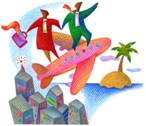
The notion of « holidays » arose in 1936, with the first legislation about « paid holidays » legalizing a two-week paid holiday a year. Among, all the decisions taken by the Popular Front government, the one concerning paid leaves took a mythical dimension through the years: «a gateway to the sea "finally became a true dream for a majority of workers and employees .
At first, the gateway would be rather short in time (12 working days) and obviously cut short due to the low standard of living. Now, since 1985, French workers have been allowed a five-week paid holiday.
Besides, thanks to the 35 hour week enforcement, 10 % of the working population can now enjoy up to 8 week paid holidays a year. There are also maternity leaves for pregnant women (a total of 16 weeks, but 6 before childbirth) as well as paternity leaves for men (2 weeks).So, any mother can spend time with his /her child; as for the father, he has to be a salaried worker, but his child should be born from January 1st 2002 onward in order to be granted a paternity leave.
France thus ranks first worldwide concerning paid leaves.

Thanks to the creation of « holiday cheques » in 1982, lower-income families could go on holidays, since they could benefit from fairly cheap price accommodation, transport, catering and various leisure activities.
One French out of two takes at least a yearly week-end holiday to visit either his family, or his friends or to enjoy a stay in the countryside.
On an average, the French take a two week holidays, usually at the same place, either in July or in August at summer time, or from December to February at winter time.
France is the most visited place. They also travel to the South, to Spain or to Italy, mostly by car.
Nowadays, holidays in France tend to be various. People wish for more culture, more sporting activities and for enjoyable time during their holidays.
Generally, French people take their holidays according to those of their children.
In France, the school holiday calendar is very well organized. We notice 3 Academic zones:
From the city to the country, from the mountains to the beach, the destinations are varied. The only important rule is relaxing.

french Holidays
January 1st: New Year's Day
|
It’s a traditional holiday; French people go and visit their relatives and friends. On the stroke of midnight everyone kisses each other, under mistletoe and wishes « happy new year »
|
The Celebration of Jesus Christ Resurrection. Easter always falls on a Sunday. Traditionally kids are offered chocolate eggs and the family share a lamb leg on that very day. This is the Easter lamb, that is to say the one Abraham killed in the place of his son. |
|
May 1st: Labour Day
|
The workers holiday. In cities, Trade Unions usually organise either meetings or demonstrations. |
May 8th: Victory of 1945 |
Commemorating the end of the Second World War. |
Ascension Day |
It always falls on a Thursday; takes place 40 days after Easter. It is a religious holiday to celebrate Jesus Christ’s Ascension with the apostles.
|
|
Pentecost |
A Religious holiday to celebrate the Holy Spirit, falls 50 days after Easter.
|
July 14th : National Holiday |
That day marked the beginning of the French revolution in 1789, and of the new republican constitution, as well as the end of the monarchy. On July 14 th 1789, French people assaulted the royal fortress and prison; this assault symbolized freedom and fight against any kind of oppression. That day became a official national holiday in 1880. |
|
A religious holiday celebrating the Immaculate Virgin Mary |
|
November : All Saints’ Day |
A catholic holiday celebrating all the saints. The day after it’s the day of the dead. Traditionally people go and set down pots of chrysanthemiums on their relative gravestones.
|
November 11th : Armistice Day |
Celebrating the end of World War I in 1918. On that day, people set down flowers on monuments, and the French President always sets down flowers on the Unknown Warrior’s grave under the Arc of Triumph. |
December 25th : Christmas Day
|
Jesus Christ’s birth celebration. It’s traditionally a family celebration; it starts on Christmas Eve December 24 th. At Midnight the Christians might attend a night mass, it is then followed by the traditional Christmas dinner, and people offer each other presents |
FOLK TRADITIONS
There are no specific folk traditions in France. However, every region has its own tradition ( Alsace, Savoy, the Bretagne.In order to explain French folklore ,xe’re going to give an example, for instance: a typical dance; Bourrée d’ Aurillac ".
Since 1932, the National Union of the French Folklore (FNFF) has aimed at a sole purpose: preserving the regional cultural patrimony by maintaining its traditions.This association is mainly composed of natives from all over France. The FNFF figures have increased all through the years. Today, they number more than 1 000 dancers and musicians.
Known and recognized for the quality of its services and its seriousness, many countries all over the world call on the FNFF. This international experience has made the group famous, and it represents France with dignity.
The elders used to sing about everyday life. They used to sing about all the various stages of life, birth, death , field hard work, happy seducing time for the lovers. The words are simple, sincere and true. " La Bourrée Aurillac" interprets some old fragments in the local language as well as more recent and usual French pieces. All the songs are accompanied on the accordion.
sur le point D'Avignon
la Mer
Old dances are still fashionable, especially when they are danced the way our elders would do it. Popular dances are both various and numerous.
These dances are in fact some sort of traditional chain, connecting generations to generations,thus creating a strong bond to our ancestors.
Female costumes :
Babarel dresses, made of rich materials (satin, watered silk), silk or cashmere shawl, black apron and Aurillac white starched headdress, black mittens, all these for holiday costumes.
For everyday life, simpler long sleeved dress, made of ordinary material, a small blouse with a row of hooks on the front, a big cloth or cotton apron, white cap or straw hat.
Male costumes :
L ong sleeved vest, white shirt, black knot, black pants and big black hat for holidays.
Stripped trousers, flannel belt, button braces, straw hat, a handkerchief round the neck at work time, a black or blue blouse on the fair days.
Children costumes :
Girls : simple long sleeved dress, or shorter with hooks on the front and a large apron, a small white cap on the head.
Boys : either black, grey or stripped trousers, a short black or blue blouse, a beret on the head

Traditional folk costumes
PETANQUE
Petanque is a game of bowls played in the South of France (Provençe).
According to the INSEE, it ranks n° 6 th among French sports. There is about 420 000 regular members practicing that sport. But during the week ends and holidays several millions of amateurs!
The Petanque rules
Fixed that way:
- 3 players v 3 players (threesomes).
For threesomes, each player gets 2 bowls
It could also be fixed that way:
- 2 players v 2 players (doublettes).
For doublettes, each player gets 3 bowls.
- 1 player v 1 player (just 2 of them).
In that case each player gets 3 bowls.
The first player draws a circle and decides of the playing distance, generally between six and ten meters away from the circle. He then throws the jack, and then he throws his bowl, trying to set it as close as possible to the goal: he rolls. The other team plays in its turn, rolls and tries to set its bowl even closer. The other possibility is to hit the other team’s bowl, to get it away. The closest bowl would win, even if it’s necessary to measure the right distance. The team with the farther bowl has to play the next game, and so on till the last bowl. We say that the game is over, and make the totals. The winner is the team who’s got as many bowls as close as possible to the jack. Then another game can start, the game is over any team gets 13.
The bowls: any kind will do, especially as a hobby, but it’s advisable not to buy plastic beach bowl type, or the colored ones; the best ones are those which are bright and heavy.
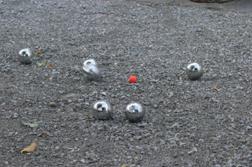
Petanque
ROYAL TENNIS
Royal tennis, a sport of rackets has been played for almost thousand years. It gets its origin from the pelota, tambourine ball game, tennis or any sports of rackets.
Royal tennis gets its origin from the royal tennis oath, one of the major events at the time of the French Revolution.
Royal tennis consists in throwing a ball above a net, just like in tennis. It is played with either 2 or 4 players (1 v 1) or (2 v 2), but also (3v 3) or (4 v 4). The winner of the game scores (15, 30, 40 ball match) is still the same in tennis. The origin of this score cannot be clearly established. The player uses a leather glove in order to protect his hand, when hitting; it was common practice by the end of the 13 th century. At first Royal tennis used to be played outdoors, but from the 15 th century onwards sports courts get roofs. At that time they used to be called «tripots".

Le Jeu de Paume (Royal tennis)
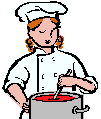
France has got a cooking history, so varied and important that it’s very hard to mention each specialty. Each region has got its specific specialities.
The three meals of the day
The regional cooking
If you ever travel around France, you’ll find a great diversity in cookery, each region has got its own traditional dish.
« Charcuterie » is a generic term referring to a wide variety of products made with pork, such as “pâté”, “rillettes”, ham sausages, black or white pudding.
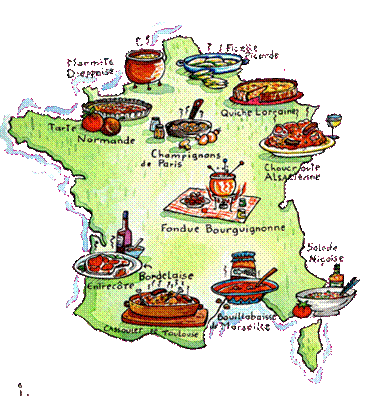
Map of regional specialities in France
SOME Recipes
BORDEAUX STEAK ENTRECOTE
6 steak entrecotes
6 shallots
40cl Bordeaux red wine
4 tablespoons olive oil
100g butter
Salt and pepper
Peel the shallots. Fry the entrecotes on a brisk moderate
Heat with a little oil, and let it cook 3/5 minutes.
Arrange the entrecotes in a serving dish, cover with an
aluminium sheet to keep them warm. Add 2 tablespoons
of water; let it simmer with the shallots, and red wine.
Prepare the gravy with the rest of butter.
Serve the entrecotes with a coat of gravy
BURGUNDY MEAT FONDUE
750g sirloin
½ l olive oil
This dish will cook on the table.
Cut the meat into small pieces.
Pour olive into a big pot that you will put in the
centre of the guest table on a special stove.
When the olive oil is boiling, every guest drops his
piece of meat into a pot, and let it cook as he wishes.
Then you eat it with any dressing of your choice
QUICHE LORRAINE
200G of pastry
150g streaky bacon
100g Swiss cheese
2 eggs
2 eggs yolks
¼ l cream Salt
Pepper
Nutmeg
Put the pastry into a tin and add the ingredients to fill the tin. Bake for about ½ an hour in a moderate oven.
TOULOUSE CASSOULET
1kg dry white beans
1 knuckle of ham
350g pork spare ribs
1 smoked sausage
Thyme
Onion
1 carrot
Some garlic
200g lard
1 tomato
3 duck or goose legs preserved in fat
400g Toulouse sausages
50g dry bread
Salt and pepper
Put the beans in cold water for about 12 hours.
On next day, set the meat in mild water.
Put the drained beans into a big pot, with all the
Ingredients, and add cold water up to the top,
Do not add any salt.
Let the whole thing simmer for about 1 hour.
Rub the inside of a big pot (casserole) with garlic,
And then add the lard.
Add half of the drained beans with the meat on
top. Add salt and pepper, plus the beans, and some
cooking water.
Put it a gently oven for about 3 hours.
Stir gently every 20 minute. At the end sprinkle some
MARSEILLE BOUILLABAISSE
200g fish conger 2 tablespoons olive oil
1 sea bream fish ½ saffron
1 scorpion fish for the rouille sauce: 3 garlic cloves
300g small squids 1 small red pepper
0.5 l mussels’ 1 egg yolk
1 l fish stock 1 slice of bread
4 bay prawns 20cl olive oil
8 clams Salt and pepper
1 carrot Slice the carrot and courgette
1 courgette
Cut all the fish, and mix it with saffron
and 2 tablespoons oil.
Prepare mussels and clams.
Prepare the rouille sauce: crush the bread
with garlic and pepper, add the egg yolk, salt
and pepper, plus olive oil as for a mayonnaise.
Heat the fish stock, add all the other ingredients.Serve hot with the rouille sauce and toasts.
FRENCH VINEYARDS

In France, there are a lot of different vineyard regions, but vine is usually grown in mild climate. 872.000 hectares are devoted to vintage crop, and there are about 144.000 vintage farms.
A mild climate, the vine diversities as well as the different French type of grounds make the vine growing easy over the whole territory.
The French vineyards regions.
It is rather common for French people to go on local wine discovery trips. In Burgundy, there’s a famous event called “Saint Vincent Tournante.” Saint Vincent used to be the Burgundy wine grower leader; it’s rather difficult to get back to the origin of such a legend.
Some people would argue that it comes from his name (vine/ blood,) or the vineyard’s blood. Some others would say that, he’d got a donkey and it is said the animal would have eaten some of the vine.As a result; the vine would have grown even stronger
The celebration of Saint Vincent regularly falls on the week end after January 22 .It has been a traditional event since 1938. Each year it takes place in a different village, that’s the reason why it is called “tournante “(turning). The villagers spend a long time decorating their houses, with Burgundy colour paper flowers (Red and Gold). They also reproduce daily vine life scenes. The villages look beautiful on that day; it’s very special with many visitors and music.
A lot of foreign tourists are used to visiting the different villages and tasting the wine production.
FRENCH CHEESE
The French usually say that there is no true dinner, if there’s neither wine nor cheese at the end of the meal. There are about 400 different sorts of cheese in our country. Each region has got its specialty, here are some samples.
Origin: Puy de Dôme, Cantal in Auvergne.
Origin : the Pyrenees.
Origin: the Jura.
Origin: Chavignol, Centre of France.
Origin: Meaux, the Ile de France ( Paris and surrounding departments)
Origin: Beauzac, Auvergne.
Origin: Savoie.
Origin: Munster, Alsatian region.
Origin: Ile de France.
10. Camembert cheese.
Origin: Normandy.
THE TABLE GOOD MANNERS.
At the restaurant:
Usually the man enters the restaurant first, preceding the woman.
He’s the one who orders the menu, and talks to the waiters, he is also the one who makes the choice of wines.
It’s not discourteous not to finish your dish.
It ‘s courteous not to speak in a loud voice.
The table arrangement:
Place the cutlery in that way, in the case of an informal meal:
Spoon and knife should be set on the right side of the plate,( the sharp part of the knife next to the plate). The fork should be set on the left, the fork tip should be up .
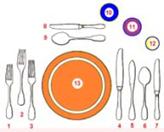
Placing of the cutleries
Use of the various cutleries:
* Your fork: you have to hold it with your right hand, if you use it alone, but with your left hand if you use your knife at the same time.
* Your knife: always hold it in your right hand, and if you cut something, press your index on the knife, but never on the top of the blade.
* The spoon: you should use it by the end, never on its side.
* Special fish cutlery: same use, but you may recognize it easily because of the large knife blade.
Table good manners: a few advice.
- Never drink before starting your meal.
As soon as you have finished your dish, you should set your fork and knife on your plate, in a parallel way, but never set those in a crossed manner. The fork tip shouldn’t be up. Glasses should never be full to the top. These table good manners are still currently used in France.